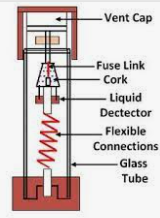- Home/
- CDS & Defence/
- Article
The Material Used in Liquid Fuses is?
By BYJU'S Exam Prep
Updated on: September 25th, 2023
(A) SF6
(B) Distilled water
(C) Carbon tetra chloride
(D) Transformer oil
The material used in liquid fuses is carbon tetrachloride. For the safety of 11KV and 33KV pole or pad-mounted transformers on rural networks as well as for Spurs, supplying a number of transformers, liquid fuses are designed.
Table of content
Importance of Liquid Fuse
The glass tube in the fuse is where the carbon tetrachloride fills up. The glass tube contains the fuse element. The tube’s one end is sealed, and the other end is fixed to the glass tube’s end with the aid of a phosphorous bronze wire.
The short-circuit current flows through the fuse element when the fault occurs. The fuse element melts and fractures. The meager amount of gas produced during fusion. The arc is put out by the liquid used in the fuse. Such a fuse is employed as the circuit’s breaker backup protector.
High voltage circuits most frequently employ liquid-type HRC fuses. These fuse types are mostly utilized for transformer protection and circuits with more than 400A of current.
Below is a diagram of a liquid fuse.

Summary:
The Material used in Liquid fuses is? (A) SF6 (B) Distilled water (C) Carbon Tetra chloride (D) Transformer oil
Liquid fuses are made of carbon tetrachloride. Liquid fuses are created for the protection of 11KV and 33KV pole or pad-mounted transformers in rural networks, as well as for Spurs, supplying a number of transformers.
